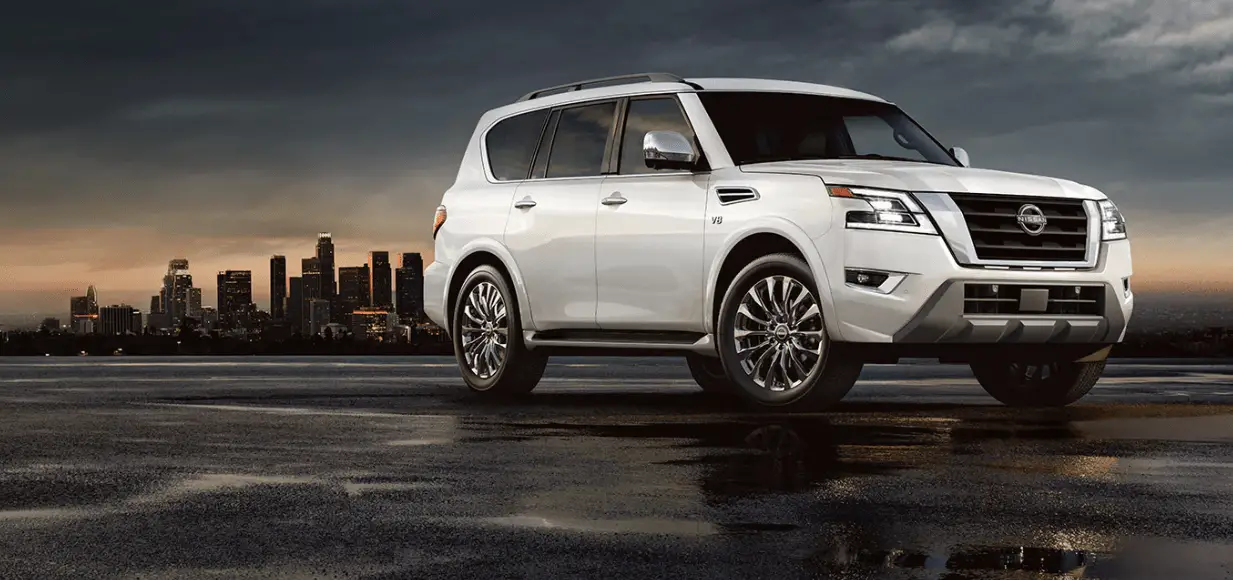Nissan ARMADA 2022 “When Travelling or Registering In Another Country
The 2022 Nissan Armada stands out as a champion of both luxury and speed in the world of cars. It’s also a reliable travel companion for trips both near and far. To get the most out of this high-tech SUV, you need to know how to travel, register, and load it properly. This is true whether you’re going on a cross-country trip, a weekend break, or just getting around town every day. This detailed guide starts an adventure into the complicated details of travelling with the 2022 Armada, from making sure you’re properly registered and following local rules to loading the vehicles most safely and efficiently possible. Whether you’re getting ready for a long road trip, wanting to explore new areas, or looking for the most comfortable and flexible car for your family, the tips in this book will help you take your Armada on a wide range of trips, revealing its full potential as a trustworthy and luxurious travel partner.
2023 Nissan Armada Specs, Price, Features and Mileage (Brochure)
WHEN TRAVELING OR REGISTERING IN ANOTHER COUNTRY
If you plan to travel in another country, you should first find out if the fuel available is suitable for your vehicle’s engine.
Using fuel with too low an octane rating may cause engine damage. All gasoline vehicles must be operated with unleaded gasoline. Therefore, avoid taking your vehicle to areas where appropriate fuel is not available.
When transferring the registration of your vehicle to another country, state, province or district, it may be necessary to modify the vehicle to meet local laws and regulations.
The laws and regulations for motor vehicle emission control and safety standards vary according to the country, state, province or district; therefore, vehicle specifications may differ.
When any vehicle is to be taken into another country, state, province or district and registered, its modifications, transportation, and registration are the responsibility of the user. NISSAN is not responsible for any inconvenience that may result.
VEHICLE IDENTIFICATION
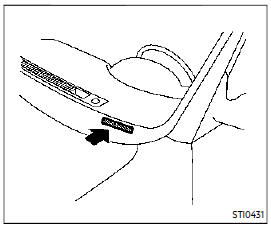
VEHICLE IDENTIFICATION NUMBER (VIN) PLATE
The vehicle identification number plate is attached as shown. This number is the identification for your vehicle and is used in the vehicle registration.
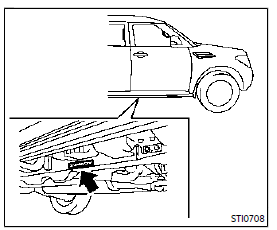
VEHICLE IDENTIFICATION NUMBER (chassis number)
The number is stamped as shown.
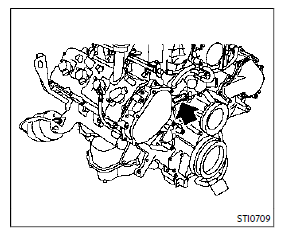
ENGINE SERIAL NUMBER
The number is stamped on the engine as shown.

F.M.V.S.S./C.M.V.S.S. CERTIFICATION LABEL
The Federal/Canadian Motor Vehicle Safety Standards (F.M.V.S.S./C.M.V.S.S.) certification label is affixed as shown. This label contains valuable vehicle information, such as: Gross Vehicle Weight Ratings (GVWR), Gross Axle Weight Rating (GAWR), month and year of manufacture, Vehicle Identification Number (VIN), etc. Review it carefully.
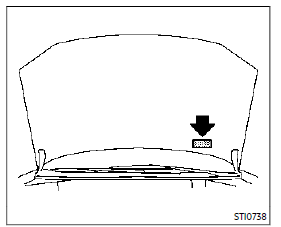
EMISSION CONTROL INFORMATION LABEL
The emission control information label is attached as shown.
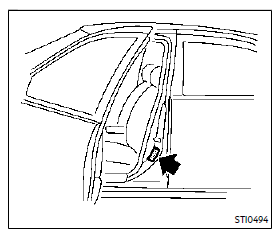
TIRE AND LOADING INFORMATION
The cold tire pressure is shown on the Tire and Loading Information label affixed to the pillar as illustrated.

AIR CONDITIONER SPECIFICATION LABEL
The air conditioner specification label is attached as shown.
| Air conditioner specification label symbols: | ||
| Symbol Name | Reference | Graphic |
| Caution | ISO 7000 0434 | |
| Air Conditioning System (MAC) | ISO 2575 D01 | |
| MAC System Lubricant Type (PAG–POE) | ||
| Requires Registered Technician to Service MAC System | ||
| Flammable Refrigerant | ||
INSTALLING FRONT LICENSE PLATE VEHICLE LOADING INFORMATION
To install the front license plate bracket to your vehicle, it is recommended you contact a NISSAN dealer.
WARNING
- It is extremely dangerous to ride in a cargo area inside the vehicle. In a collision, people riding in these areas are more likely to be seriously injured or killed.
- Do not allow people to ride in any area of the vehicle that is not equipped with seats and seat belts.
- Be sure everyone in your vehicle is in a seat and using a seat belt properly.
TERMS
It is important to familiarize yourself with the following terms before loading your vehicle:
- Curb Weight (actual weight of your vehicle) – vehicle weight including standard and optional equipment, fluids, emergency tools, and spare tire assembly. This weight does not include passengers and cargo.
- GVW (Gross Vehicle Weight) curb weight plus the combined weight of passengers and cargo.
- GVWR (Gross Vehicle Weight Rating) – the maximum total combined weight of the unloaded vehicle, passengers, luggage, hitch, trailer tongue load and any other optional equipment. This information is located on the F.M.V.S. S./C.M.V.S.S. label.
- GAWR (Gross Axle Weight Rating)
- maximum weight (load) limit specified for the front or rear axle. This information is located on the F.M.V.S.S./C.M.V.S.S. label.
- GCWR (Gross Combined Weight
Rating) – The maximum total weight rating of the vehicle, passengers, cargo, and trailer. - Vehicle Capacity Weight, Load limit, Total load capacity – maximum total weight limit specified of the load (passengers and cargo) for the vehicle. This is the maximum combined weight of occupants and cargo that can be loaded into the vehicle. If the vehicle is used to tow a trailer, the trailer tongue weight must be included as part of the cargo load. This information is located on the Tire and Loading Information label.
- Cargo capacity – the permissible weight of cargo, the weight of total occupants weight subtracted from the load limit.

VEHICLE LOAD CAPACITY
Do not exceed the load limit of your vehicle shown as “The combined weight of occupants and cargo” on the Tire and Loading Information label. Do not exceed the number of occupants shown as “Seating Capacity” on the Tire and Loading Information label.
To get “the combined weight of occupants and cargo”, add the weight of all occupants, then add the total luggage weight. Examples are shown in the illustration.
Steps for determining the correct load limit
- Locate the statement “The combined weight of occupants and cargo should never exceed XXX kg or XXX lbs” on your vehicle’s placard.
- Determine the combined weight of the driver and passengers that will be riding in your vehicle.
- Subtract the combined weight of the driver and passengers from XXX kg or XXX lbs.
- The resulting figure equals the available amount of cargo and luggage load capacity. For example, if the XXX amount equals 1400 lbs. and there will be five 150 lb. passengers in your vehicle, the amount of available cargo and luggage load capacity is 650 lbs. (1400 − 750 (5 x 150) = 650 lbs) or (640 − 340 (5 x 70) = 300 kg.)
- Determine the combined weight of luggage and cargo being loaded on the vehicle. That weight may not safely exceed the available cargo and luggage load capacity calculated in Step 4.
- ‘If your vehicle will be towing a trailer, load from your trailer will be transferred to your vehicle. Consult this manual to determine how this reduces the available cargo and luggage load capacity of your vehicle.
Before driving a loaded vehicle, confirm that you do not exceed the Gross Vehicle Weight Rating (GVWR) or the Gross Axle Weight Rating (GAWR) for your vehicle.
Also check tires for proper inflation pressures. See the Tire and Loading Information label.
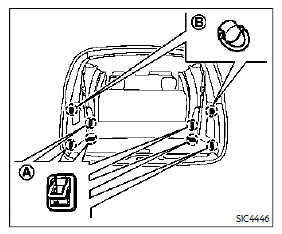
SECURING THE LOAD
There are tie-down hooks located in the cargo area as shown. The tie-down hooks can be used to secure cargo with ropes or other types of straps.
Do not apply a total load of more than 22 lb (10 kg) to a single hook or 7 lb (3 kg) to a single hook when securing cargo.
WARNING
- Properly secure all cargo with ropes or straps to help prevent it from sliding or shifting. Do not place cargo higher than the seatbacks. In a sudden stop or collision, unsecured cargo could cause personal injury.
- The child restraint top tether strap may be damaged by contact with items in the cargo area. Secure any items in the cargo area. Your child could be seriously injured or killed in a collision if the top tether strap is damaged.
- Do not load your vehicle any heavier than the GVWR or the maximum front and rear GAWRs. If you do, parts of your vehicle can break, tire damage could occur, or it can change the way your vehicle handles. This could result in loss of control and cause personal injury.
LOADING TIPS
- The GVW must not exceed GVWR or GAWR as specified on the F.M. V.S.S./C.M.V.S.S. certification la-bel.
- Do not load the front and rear axle to the GAWR. Doing so will exceed the GVWR.
WARNING
- Properly secure all cargo to help prevent it from sliding or shifting. Do not place cargo higher than the seat-backs. In a sudden stop or collision, unsecured cargo could cause personal injury.
- Do not load your vehicle any heavier than the GVWR or the maximum front and rear GAWRs. If you do, parts of your vehicle can break, tire damage could occur, or it can change the way your vehicle handles. This could result in loss of control and cause personal injury.
- Overloading not only can shorten the life of your vehicle and the tire, but can cause unsafe vehicle handling and long braking distances. This may cause a premature tire failure, which could result in a serious accident and personal injury. Failures caused by overloading are not covered by the vehicle’s warranty.
MEASUREMENT OF WEIGHTS
Secure loose items to prevent weight shifts that could affect the balance of your vehicle. When the vehicle is loaded, drive to a scale and weigh the front and the rear wheels separately to determine axle loads. Individual axle loads should not exceed either of the gross axle weight ratings (GAWR). The total of the axle loads should not exceed the gross vehicle weight rating (GVWR). These ratings are given on the vehicle certification label. If weight ratings are exceeded, move or remove items to bring all weights below the ratings.
FAQ
Yes, the 2022 Nissan Armada is designed for long-distance travel and offers a comfortable and spacious interior for extended journeys.
Before a long trip, it’s essential to check tire pressure, engine oil, coolant levels, brake fluid, and ensure all lights and signals are functioning correctly.
Yes, the 2022 Armada is often equipped with towing capabilities, allowing you to tow trailers, boats, or other recreational vehicles. Ensure you’re within the vehicle’s towing capacity and follow safe towing practices.
Yes, you must register your 2022 Nissan Armada with the DMV to legally operate it on public roads. The registration process varies by location, so check your local DMV for specific requirements.
To obtain license plates for your Armada, you typically need to provide proof of ownership, insurance, and pass any required inspections. The DMV will issue the plates upon completion of the registration process.
The GVWR of the 2022 Nissan Armada can vary depending on the trim level and equipment, but it is generally around 7,000 to 7,500 pounds.
Yes, you can often install a roof rack or cargo carrier on the Armada’s roof rails to increase cargo capacity for long trips.
The recommended maximum load capacity for the roof rack or cargo carrier can vary by design and manufacturer. Always adhere to the manufacturer’s guidelines to prevent damage and ensure safety.
Distributing the load evenly inside the Armada is essential for safe handling and performance. Heavier items should be placed low and centered, and cargo should be secured to prevent shifting during travel.
The recommended tire pressure for a fully loaded Armada can vary depending on the specific load and the vehicle’s specifications. Refer to the owner’s manual or the driver’s door jamb for the correct tire pressure.
Yes, you can often use a roof-mounted cargo box to increase storage capacity during travel. Ensure it is properly installed and within the roof rack’s weight capacity.
The maximum towing speed for the Armada can vary, but it’s typically recommended to stay within the legal speed limits and follow any specific guidelines provided in the owner’s manual or by the trailer manufacturer.
When traveling to a different state or country, ensure that your Armada complies with all local laws and regulations, including vehicle inspections, emissions standards, and insurance requirements.
Yes, you can transport passengers in the rear seats while towing a trailer, but you should consider the combined weight and ensure that it doesn’t exceed the vehicle’s Gross Combined Weight Rating (GCWR).
Before a road trip, perform routine maintenance checks as mentioned earlier. After the trip, inspect the vehicle for any wear and tear, and consider an oil change and thorough cleaning to keep your Armada in top condition.
Useful Link
View Full User Guide: Nissan ARMADA 2022 User Guide
Download Manuals: https://www.nissanusa.com/owners/ownership/manuals-guides.html
2023 Nissan Armada Specs, Price, Features and Mileage (Brochure)

